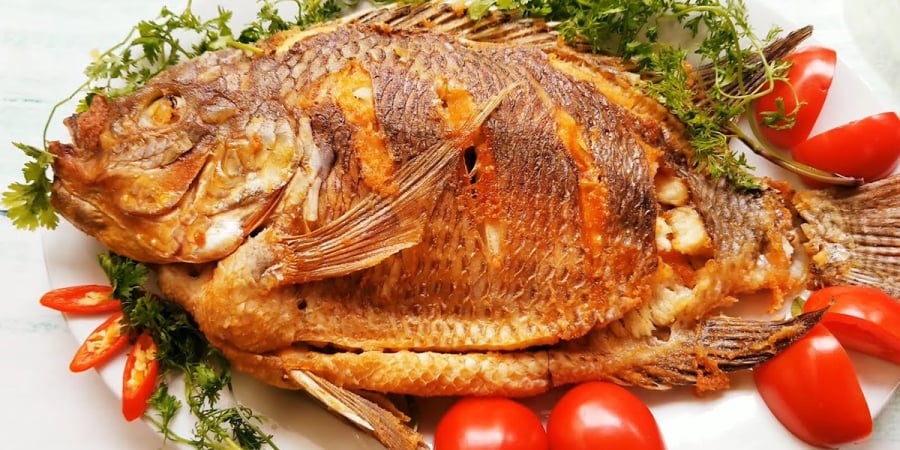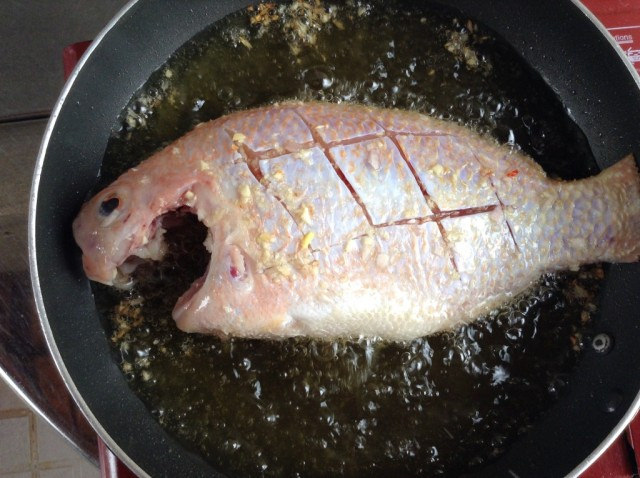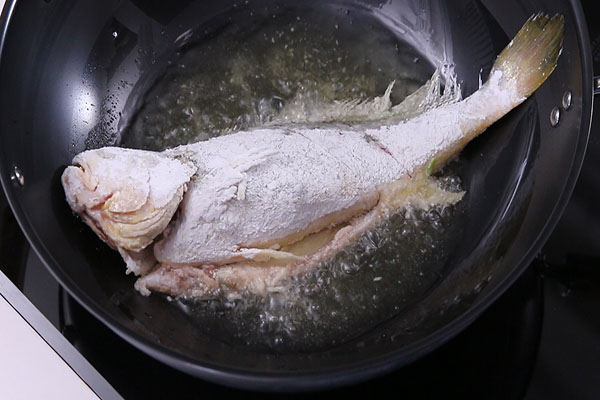Fried fish is a delicious and popular dish for family meals. When frying fish, you just need to remember this small tip that will make the dish more complete and appealing.

The surface of the fish must be dry before frying
First, prepare and clean the fish by removing scales, gutting, and scraping the black membrane inside the fish’s belly…
This is an important step to reduce the fishy smell. Put the cleaned fish in a bowl, add a little wine for aroma, along with salt and ginger, and let it sit for 10 minutes. This helps enhance the flavor of the fish after frying and also reduces the moisture on the surface of the fish skin, preventing it from sticking to the pan. If you fry the fish immediately after washing it, the water on the surface of the fish will splatter and create a mess in the pan. Therefore, before frying the fish, use a paper towel to dry the entire surface of the fish.

Brush egg white or vinegar/sugar on the fish
Before frying the fish, brushing egg white on the entire surface of the fish will make it more flavorful, prevent it from sticking to the pan, and give it a crispy skin.
Alternatively, after the fish has dried, you can spread a thin layer of vinegar on the fish’s surface. Then sprinkle a little sugar on the fish and use a paper towel to dry it. Chefs explain that applying vinegar and sugar to the fish’s surface is a way to protect the fish’s skin, preventing it from breaking when frying. Moreover, fried fish will have a crispy skin and a beautiful golden-red color.
Rub ginger on the pan
Place the pan on the stove, when the pan starts to heat up, rub a slice of fresh ginger evenly on the entire bottom and sides of the pan. Add cooking oil and wait until the oil is hot, then carefully place the cleaned fish in to fry. Avoid putting the fish too early, as it may stick to the pan. This simple tip not only gives the fish a golden and appealing color but also imparts a characteristic ginger aroma to the fish.
Dust some starch on the fish

If you don’t brush egg white on the fish, you can dust some starch on it. After preparing the fish, roll it in a plate of starch to evenly coat the fish with starch. Add an appropriate amount of cooking oil to a pan and heat it up (around 70 degrees Celsius). Sprinkle some starch into the pan, shake the pan from left to right a few times to mix the starch with the oil, then put the fish into the pan and fry until golden on both sides. With this method, the fried fish is guaranteed to be crispy, without sticking to the pan.
Control the heat when frying the fish
Throughout the frying process, it is best to keep the heat low to allow the fish to cook gradually. Only when the fish is cooked, turn up the heat to make the outside skin of the fish golden and crispy.
In addition, when frying the fish, you should pay attention to the temperature of the cooking oil. You should wait until the oil reaches the right temperature before putting the fish in to fry. If the oil is not hot enough, or if you put the fish in immediately after pouring in the oil, the fish will stick to the pan and easily break apart, and it won’t turn out crispy and golden.
To check if the oil is hot enough, you can dip a chopstick into the oil. If the oil is boiling and bubbles appear around the chopstick, it is ready.
Exploring Alternative Cooking Methods for Better Health – Part 2
Are you interested in providing nutricious meals for your family, but don’t know what cooking methods to use? Don’t let your lack of cooking skills keep you from providing the best possible health benefits for your family! Discover the different healthy cooking techniques that can maximize the nutrition in each delicious dish you create.
Expert Advice on How to Identify Unsafe Food
Are you aware of how to inspect food for possible safety risks? With the presence of food products from unclear origins and chemicals used as preservatives, it is important to be vigilant in selecting food items for our families. Join us in the Food Tips section to take a closer look at how to select safe and healthy food for our families!






































